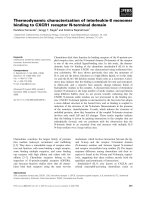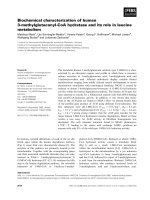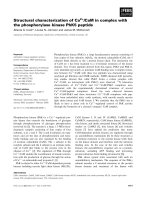Báo cáo khoa học: "Genetic characterization of Barbari goats using microsatellite markers" docx
Bạn đang xem bản rút gọn của tài liệu. Xem và tải ngay bản đầy đủ của tài liệu tại đây (210.38 KB, 4 trang )
JOURNAL OF
Veterinary
Science
J. Vet. Sci. (2009), 10(1), 73
76
DOI: 10.4142/jvs.2009.10.1.73
*Corresponding author
Tel: +91-44-25388997; Fax: +91-44-25388997
E-mail:
Genetic characterization of Barbari goats using microsatellite markers
J. Ramamoorthi, K. Thilagam, S. N. Sivaselvam
*
, S. M. K. Karthickeyan
Department of Animal Genetics and Breeding, Madras Veterinary College, Tamilnadu Veterinary and Animal Sciences
University, Chennai-600 007, India
Genetic variation in Barbari goats, a highly prolific breed
distributed widely in the northern part of India, known for
better milk and meat quality, was studied as a part of genetic
characterization and conservation. The genomic DNA from
50 unrelated Barbari goats were amplified via PCR with a
panel of 21 microsatellite markers, and resolved through 6 per
cent denaturing polyacrylamide gel electrophoresis followed
by silver staining. The number of alleles ranged from 4 to 11,
with allele sizes ranging from 88 to 220 bp. The distribution
of allele frequencies was between 0.0104 and 0.5208.
Polymorphism information content varied from 0.5563 to
0.8348. The population was not in Hardy-Weinberg equilibrium
for all except two microsatellite loci (ILSTS044 and
ILSTS060). The observed heterozygosity ranged from 0.8478
to 1.0000 while the expected heterozygosity ranged from
0.6208 to 0.8509. Based on the results of the present study,
there is a good scope for exploiting the genetic variability in
the Barbari goats for further improvement of performance.
Keywords:
Barbari goats, genetic characterization, heterozygosity,
microsatellite markers, polymorphism
Introduction
Breed characterization requires basic knowledge of
genetic variations that can be effectively measured within
and between populations. The characterization data of
Indian goats is imprecise because earlier studies based on
morphological and biochemical markers did not present a
true picture of their relationships. These markers have
many limitations in identifying breed specificity, as they
do not have high resolving and distinguishing power among
the closely related breeds in terms of coat colour, horn
types, limited polymorphic nature of the serum proteins or
biochemical variants, etc. Molecular markers are more
accurate and reliable than all other markers [9] because of
their dense distribution in the genome, great variation, co-
dominant inheritance and easy genotyping at DNA level.
Among the various molecular genetic markers such as
Restriction Fragment Length Polymorphisms (RFLPs),
Random Amplified Polymorphic DNA (RAPD) and Variable
Number of Tandem Repeats (VNTRs), microsatellites were
found to be common in all eukaryotic genomes with
frequencies as high as one marker per every 6 kb [3], and
easy to type via polymerase chain reaction (PCR).
Microsatellites have a number of advantages over the
conventional RFLPs, RAPDs and VNTRs or minisatellites,
such as simplified analysis, relative abundance, high
heterozygosities, a greater degree of polymorphisms, and
Mendelian inheritance [9]. The Food and Agriculture
Organization (FAO) of the United Nations has proposed an
integrated programme for the global management of genetic
resources, Project MODAD (DAD-IS; FAO, Rome), using
microsatellite methodology for breed characterization.
Most of the studies using microsatellites have concentrated
on cattle, sheep and pigs, while information available about
the genetic characterisation of goats is limited [2,7,8,14,15].
The scarcity of polymorphic markers in the goat is a major
drawback for construction of linkage maps, since limited
attempts have been made so far in this direction. In order to
develop objective criteria for the conservation and genetic
improvement of goat breeds in India, the present study was
carried out to characterize the Barbari goat using
microsatellite markers.
Barbari goats are small, short-haired and distributed across
Uttar Pradesh and Rajasthan States of India; the most
typical colour is white with small light brown patches [1].
The highly prolific breed is quite important for milk and
meat and highly suited for rearing under stall-fed conditions.
Considering the small number of animals reported (about
30,000), there is a serious need for undertaking conservation
measures [1].
Materials and Methods
The investigation was carried out on 50 unrelated animals of
Barbari goats using 21 microsatellite markers. Detailed
74 J. Ramamoorthi et al.
Microsatellite
marker
Repeat structure
Annealing
temperature (
o
C)
No. of alleles
Allele size
range (bp)
PIC
Heterozygosity
Observed Expected
ILSTS001
ILSTS002
ILSTS004
ILSTS008
ILSTS019
ILSTS022
ILSTS028
ILSTS029
ILSTS038
ILSTS040
ILSTS044
ILSTS049
ILSTS052
ILSTS058
ILSTS059
ILSTS060
ILSTS065
ILSTS072
ILSTS078
ILSTS082
ILSTS087
(TG)
15
(CA)
17
(CA)
16
(CA)
12
(TG)
10
(GT)
21
(CA)
7
(CA)
19
(NN)
30
(TG)
28
(GT)
20
(CA)
26
(CA)
12
(GT)
15
(CA)
4
(GT)
21
(GT)
8
(CA)
22
(CA)
14
(CA)
4
(GT)
15
(GT)
17
(CA)
14
58
58
53
58
50
58
55
55
55
53
55
55
55
55
55
55
55
55
55
55
55
4
5
6
6
7
6
7
8
5
5
8
6
5
8
4
11
6
8
7
5
6
88-94
122-134
104-124
160-176
128-172
90-152
132-150
164-180
146-170
172-184
142-170
156-168
122-136
92-122
174-188
170-220
150-162
154-168
136-154
110-120
110-120
0.6761
0.5563
0.6957
0.6616
0.5804
0.6096
0.7558
0.8348
0.5603
0.6921
0.7161
0.7802
0.6508
0.7920
0.5816
0.7347
0.7460
0.6569
0.7225
0.6395
0.7662
0.8636
0.9778
0.9761
0.9777
0.9583
0.8510
1.0000
0.9111
0.9166
1.0000
0.9130
1.0000
0.9782
0.9583
0.9791
0.9565
0.8860
0.9555
0.8478
0.9772
0.8837
0.7266
0.6273
0.7409
0.7083
0.6452
0.6699
0.7849
0.8509
0.6208
0.7390
0.7520
0.8078
0.7008
0.8123
0.6495
0.7643
0.7750
0.7047
0.7614
0.6943
0.6814
Tab l e 1 . Details on microsatellite markers used, number and size of the alleles, polymorphism information content
information on these markers is presented in Table 1. Five ml
of blood was collected from external jugular vein using the
vacutainer tube containing EDTA as an anticoagulant. The
samples were brought to the laboratory in an icebox and stored
at 4ºC till further processing. The samples were collected at
random irrespective of age and sex of Barbari goats.
PCR conditions and fragment analysis
Genomic DNA was isolated from five ml of blood by a
rapid, non-enzymatic method [10]. The amplification
reactions were carried out using a programmable thermal
cycler (MJ Research, USA). Each 20 μl PCR reaction
contained 50 ng template DNA (the DNA isolated was
diluted using Tris EDTA buffer at 1 in 25, 50 and 100
dilutions so as to obtain the working template DNA
concentration of approximately 20 to 50 ng of DNA per
μl); 5 pmol of each primer (Microsynth, Switzerland) (list
of primers used are given in Table 1); 500 μM each of
dNTPs (Sigma-Aldrich, USA); 0.7 unit of Taq DNA
polymerase (New England Biolabs, UK); 1 μl of 1.5 mM
MgCl
2
(New England Biolabs, UK). A total of 50 PCR
reactions per primer were carried out for all 21 primer sets
to characterize the Barbari goats. The PCR reaction cycle
was accomplished by initial denaturation for 3 min at 94
o
C,
denaturation at 94
o
C for 45 sec, primer annealing for 45 sec
at the desired temperature, and an extension for 45 sec at
72
o
C, repeating the cycle 30 times. The final extension step
was given at 72
o
C for 10 min. The amplified PCR products
were electrophoresed in 6% denaturing urea polyacrylamide
gel at a constant voltage of 1,300 volts for a period of 3 h
depending upon the size of PCR products and silver stained
[5]. The gels were lifted on cellophane sheet (Bio-Rad, USA)
and blotting paper (Bio-Rad, USA) and dried at 80
o
C for 45
min. The alleles were scored manually and analyzed by
software aided gel documentation system (Bio-Rad, USA).
The exact allele sizes were determined by direct comparison
with adjacent PCR bands and 10 bp ladder (Invitrogen, USA).
Allele frequencies were estimated from the genotypes of
the goats. The polymorphism information content (PIC)
was calculated using the individual frequencies in which the
alleles occur at each locus [12]. The heterozygosity at the
locus was estimated using Nei’s formula [11]. The expected
number of genotypes was compared with the observed
genotypes in a Chi-square test for goodness of fit to assess
whether the study population was in Hardy-Weinberg
equilibrium at these 21 microsatellite loci.
Results
The results of the microsatellite analysis in terms of number
Genetic characterization of Barbari goats 75
of alleles observed, alleles size, polymorphism information
content and heterozygosity of Barbari goats were furnished
in Table 1. In total, 133 alleles were observed for the 21
microsatellite loci analyzed. The number of alleles per locus
ranged from 4 (ILSTS001, ILSTS059) to 11 (ILSTS060)
with a mean of 6.3 alleles per locus. The allele sizes ranged
from 88 bp (ILSTS001) to 220 bp (ILSTS060). The frequency
of the alleles ranged from 0.0104 (ILSTS019) to 0.5208
(ILSTS038). The PIC values ranged from 0.5563 (ILSTS002)
to 0.8348 (ILSTS029). Except at ILSTS044 and ILSTS060,
there were significant differences (p ≤ 0.05) between
observed and expected number of genotypes at all other
loci, indicating that these loci were not in Hardy-Weinberg
equilibrium. The observed heterozygosity ranged from
0.8478 to 1.0000 while the expected heterozygosity ranged
from 0.6208 to 0.8509 across the 21 microsatellite markers.
Discussion
There is dearth of published reports on the number of
alleles, their sizes and frequencies for these microsatellite
loci in goats. The number of alleles available in literature
was seven for ILSTS008, nine for ILSTS029 and three for
ILSTS059 in Swiss goat breeds [14] and 11 for ILSTS087
in Moroccan and French goat breeds [13]. It has been
reported that there was a positive relationship between the
number of dinucleotide repeats and the number of alleles at
a given locus, with the number of alleles per locus ranging
from one to 18 [4]. Greater the number of alleles at given
locus, more informative will be the marker.
The PIC estimated in the present study are comparable
with those values obtained in Chinese goat breeds, which
ranged from 0.746 to 0.800 [15], using ovine microsatellite
markers. In contrast, lower PIC values were obtained for
Korean (0.350), Chinese (0.620) and Saanen (0.570) goats
[8]. An average PIC value of 0.48 was reported in three
Indian goat breeds (Sirohi, Jamnapari and Barbari) using
cattle microsatellite markers [6]. Based on the PIC values,
the microsatellite primers used in the present study are
proved to be highly polymorphic in nature and hence can
be well utilized for molecular characterization of goat
germplasm. In general, the PIC values are suggestive of
high polymorphic nature of the microsatellite loci analysed.
It refers to the value of a marker for detecting polymorphism
within a population, depending upon the number of
detectable alleles and the distribution of their frequency
and has been proved to be a general measure of how
informative a marker is. The studies referred above had
used either cattle or sheep microsatellite markers in goats.
While in the present study, goat-specific microsatellite
markers have been used and hence the PIC values are more
accurate and pertinent.
The Chi-square values revealed that 19 out of 21 loci were
not in Hardy-Weinberg equilibrium indicating that these
loci have not been subjected for any of the systematic
(selection, migration and mutation) and dispersive forces
(genetic drift and inbreeding). The heterozygosity is an
appropriate measure of genetic variability within a
population because genetic diversity can be measured as
the amount of actual or potential heterozygosity. The
observed and expected heterozygosity obtained in the study
are comparable with the earlier studies in Chinese goat
breeds, 0.777 to 0.823 [15]. However, lower heterozygosity
values (0.351 and 0.671) were reported for bovine and
ovine microsatellite markers in Korean and Chinese goats
[8]. The higher heterozygosity values observed has resulted
in instability of the population at the majority of
microsatellite loci studied. Because of higher heterozygosity
and consequent non-fixation of alleles at these loci, there is
further scope for improvement of the breed.
To conclude, all the 21 microsatellite markers used in the
present study were shown to be highly polymorphic and
more useful for the molecular characterization of Barbari
goats. The information elucidated through the present
study would be useful for the formulation of effective
conservation strategies and identification of quantitative
trait loci for marker-assisted selection.
Acknowledgment
The authors are highly thankful to Dr. P. Thangaraju,
Principal Investigator of the ICAR-NBAGR funded Core
Laboratory for the laboratory facilities provided for this
work.
References
1. Acharya RM. Sheep and goat Breeds of India. FAO Animal
Production and Health Paper 30. pp. 62-64, FAO, Rome,
1982.
2. Barker JSF, Tan SG, Moore SS, Mukherjee TK,
Matheson JL, Selvaraj OS. Genetic variation within and
relationships among populations of Asian goats (Capra
hircus). J Anim Breed Genet 2001, 118, 213-233.
3. Beckman JS, Weber JL. Survey of human and rat
microsatellites. Genomics 1992, 12, 627-631.
4. Bishop MD, Kappes SM, Keele JW, Stone RT, Sunden
SLF, Hawkins GA, Toldo SS, Fries R, Grosz MD, Yoo J,
Beattie CW. A genetic linkage map for cattle. Genetics
1994, 136, 619-639.
5. Comincini S, Leone P, Redaelli L, De Giuli L, Zhang Y,
Feretti L. Characterization of bovine microsatellites by
silver staining. J Anim Breed Genet 1995, 112, 415-420.
6. Ganai NA, Yadav BR. Genetic variation within and among
three Indian breeds of goat using heterologous microsatellite
markers. Anim Biotechnol 2001, 12, 121-136.
7. Kemp SJ, Hishida O, Wambugu J, Rink A, Longeri ML,
Ma RZ, Da Y, Lewin A, Barendse W, Teale AJ. A panel of
polymorphic bovine, ovine and caprine microsatellite
markers. Anim Genet 1995, 26, 299-306.
76 J. Ramamoorthi et al.
8. Kim KS, Yeo JS, Lee JW, Kim JW, Choi CB. Genetic
diversity of goats from Korea and China using microsatellite
analysis. Asian-Aust J Anim Sci 2002, 15, 461-465.
9. Koreth J, O'Leary JJ, O'D McGee J. Microsatellites and
PCR genomic analysis. J Pathol 1996, 178, 239-248.
10. Lahiri DK, Nurnberger JI Jr. A rapid non-enzymatic
method for the preparation of HMW DNA from blood for
RFLP studies. Nucleic Acids Res 1991, 19, 5444.
11. Nei M. The theory and estimation of genetic distance. In:
Morton NE (ed.). Genetic Structure of Populations. pp.
45-54, University Press of Hawaii, Honolulu, 1973.
12. Nei M. Estimation of average heterozygosity and genetic
distance from a small number of individuals. Genetics 1978,
89, 583-590.
13. Ouafi AT, Bailliot JM, Leroux C, Martin P. Genetic diversity
of the two main Moroccan goat breeds: Phylogenetic relation-
ships with four breeds reared in France. Small Rumin Res
2002, 45, 225-233.
14. Saitbekova N, Gaillard C, Obexer-Ruff G, Dolf G. Genetic
diversity in Swiss goat breeds based on microsatellite
analysis. Anim Genet 1999, 30, 36-41.
15. Yang L, Zhao SH, Li K, Peng ZZ, Montgomery GW.
Determination of genetic relationships among five indigenous
Chinese goat breeds with six microsatellite markers. Anim
Genet 1999, 30, 452-455.









